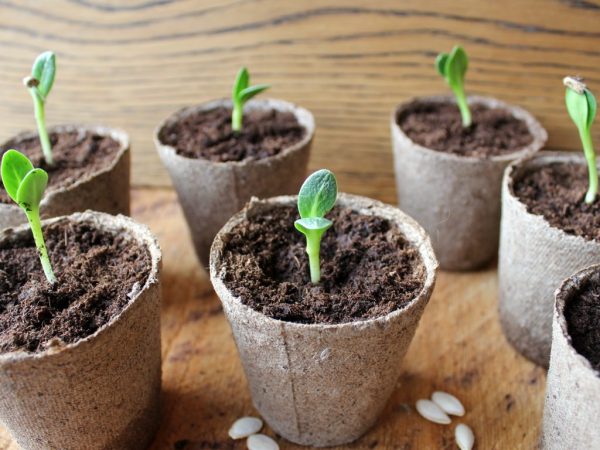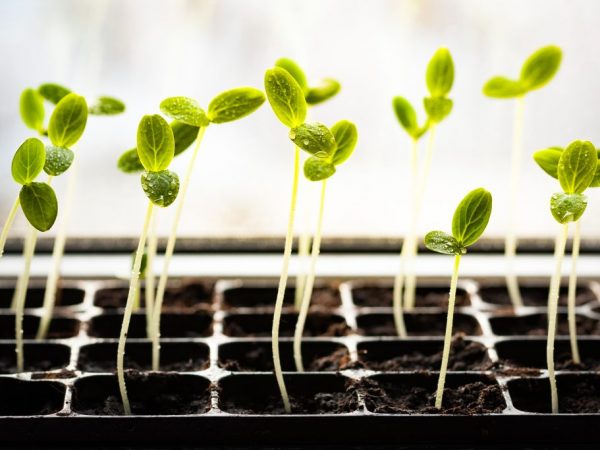How many days do cucumber seeds usually sprout
An integral stage of planting cucumbers is planting seeds, that is, sowing. Every gardener is looking forward to the first shoots appearing. However, it happens that it takes a long time to wait for the first shoots, or the sprouted shoots die soon or do not appear at all. Why is this happening, and how many days do cucumber seeds sprout normally, today we will talk about this.

Germination dates of cucumber seeds
How long do cucumber seeds sprout
There are many factors that prevent cucumber seeds from sprouting. Do not forget that we are talking about a thermophilic plant that does not like a sharp drop in temperature. In addition, the reason for the non-germinated seed can be its poor quality. In order for the seed to hatch on time, it is worth waiting for the right time when the soil warms up and, according to forecasts, there will be no frost on the soil if you plan to plant in open ground, that is, in a garden bed. As for the greenhouse, the planting of seeds can be done a little earlier in comparison with open ground - about 3 weeks.
How many days do cucumbers sprout? If all of the above conditions are met, then the first shoots can appear within 4-6 days after planting the seeds. If you sowed in heavy soil, it is worth digging them deeper, but even this will not help the first shoots to hatch earlier than 6-8 days.
Germination phase
Germination of a cucumber sprout is the most sensitive phase, because it is highly likely that for one reason or another this may not happen. In order to understand the reasons, it is worthwhile to familiarize yourself in more detail with what a cucumber seed is and how it ripens.
The cucumber seed is a somewhat elongated white formation, inside of which there is an embryo, which is reliably protected by the seed coat. This shell protects the seed from negative factors:
- Mechanical damage
- Drying out
- Early germination
- Damage by certain microorganisms
In order for an outgrowth to appear in open ground or in a greenhouse, conditions are needed that will force the peel to open. For this to happen, it is necessary to ensure sufficient watering, create the right temperature and good ventilation. With regard to lighting, the cucumber seed germinates equally well, both in the light and without it.
The beginning of the life cycle
The life cycle of a cucumber seed begins with moisture saturation until the required amount of water is absorbed. Immediately after this, the process of swelling of the seed begins, it is at this time that the opening of the peel begins, and then the activation of the enzyme system, the beginning of aerobic activity. It is worth saying that in order for these processes to occur, it is important to create the necessary moisture conditions:
- To saturate the seed, you need about 40% moisture in the soil after planting.
- During swelling, the indicator changes and grows up to 70% and even up to 80% if the plant is planted in a garden
In addition, it is important to note that the above processes can occur only if the temperature does not drop below 25 degrees. If the readings fall below, there is a risk that immediately after swelling, the seeds will grow moldy, making further growth impossible.
Seed embryo development
After the previous stage has ended, the stage of development of the embryo begins. This is accompanied by many chemical reactions that are aimed at breaking down starch, oxidizing lipids and, of course, the formation of proteins and amino acids. As a result of this, an embryonic root is formed, now the nutrition of the future plant occurs only due to the absorption of nutrients from the soil by it.
Due to the influence of the environment, the rootlet easily and quickly gets rid of the peel, this happens directly in the soil after sowing. In case you have planted the seeds too deep, you may see roots that have not shed their peels. Unfortunately, they will no longer be able to sprout, since under the influence of air and sun, the peel quickly hardens, sealing a young sprout in itself. To remedy the situation, you need to spray the seedling with a spray bottle or sprayer, and then carefully peel off the skin with your fingers.
Why the seeds don't sprout

Seven main factors affect seed germination
Let's figure out what factors negatively affect the germination of cucumber seeds. It is customary to single out seven main reasons, we will dwell on each of them in more detail.
Soil temperature
If the soil temperature in the bed is too low, namely, it drops below 12 degrees, the risk increases that the seeds will begin to mold and will not sprout. For germination, the ideal temperature is considered to be from 23 to 27 degrees, then cucumber seeds germinate in 4-5 days. Despite the recommended temperature conditions, seedlings can grow at 15-17 degrees, but the process can be significantly delayed and the ascent will not be simultaneous.
The seed is not buried properly
It is recommended to bury the seed of a cucumber to a depth of no more than two sentiments, then the young sprout will easily break through the earth layer. If you increase the depth, there is a chance that the seedlings will not emerge. In the case when the depth is less, the peel from the seedlings will not be able to come off, this situation was described earlier.
Heavy ground
The heavier the soil, the less amicably the sprouts sprout. If this factor is also combined with a low temperature, then most likely you will not wait for sprouts. If you still have to plant seeds in heavy soil, it is recommended to make a small groove before planting, its depth should be about 1-2 centimeters.
It is necessary to sow seeds into it, and pour lighter soil or sifted soil on top, the thickness of the filling layer should be about 2 centimeters. If the seeds are covered with too heavy soil, then a crust of soil may form, which the sprouts will not be able to break through.
Dry soil
Before the seeds are placed in the ground, you need to moisten the soil well, this watering is usually called moisture charging. If the water temperature is too cold, then it is better to wait a little so that the soil has time to warm up to the sowing rock.
If the soil is allowed to dry out on the eve of sowing, this will slow down the ascent of seeds, this period will last not 4-5 days, but 10 and longer than the standard period.
Moreover, there is a risk that the seedlings may simply die, as the embryonic root dries up. Usually, the soil dries up on hot summer days, consider this fact when planning seedlings.
Excessively moist soil
Usually, the problem of excessive moisture concerns soils with a high clay content.If such land is intensively watered, that is, to exceed the permissible volume and frequency of watering, there is a risk that the seedlings will be rare or the seeds will simply die.
Improper seed preparation
There are many ways of pre-sowing preparation and feeding of seeds, if you use several at once, this, on the contrary, will negatively affect the germination of cucumber seeds. If you increase the concentration of the steeping solution, there is a risk that the seed will burn and will not be able to germinate and stretch afterwards.
If, for example, after being saturated with biologically active substances, the seeds of a cucumber are dried, then embryonic roots may not appear, respectively, germinating seeds will not appear soon. Pre-sowing preparation at home must be carried out correctly.
Seed storage error
It is important that for the entire storage period the maximum permissible level of conditioned germination is ensured, it remains for 7-10 years. However, it is necessary to create special conditions for the storage to take place correctly, this can be done even at home.
The first thing to remember is that they must be stored in a dry place and cool enough, at home - it can be a basement or a cellar. To create the most favorable conditions, the seeds are usually covered with film, paper or any dense material. Do not use woven fabric, as there are gaps between the weaves that will not give you the ability to maintain the desired temperature.
Now you know how long cucumbers germinate, what factors influence this process and exactly how the cucumber seed ripens.


